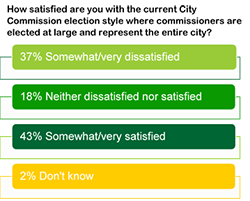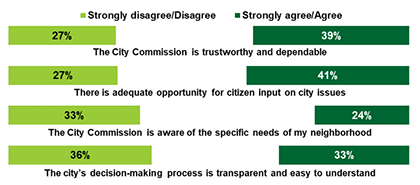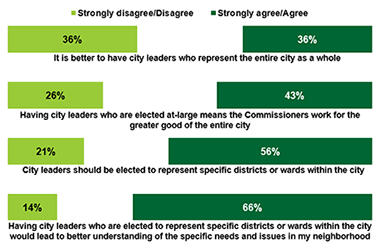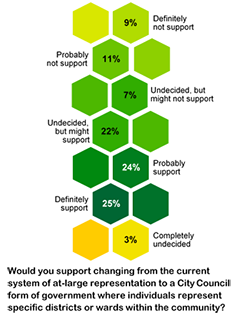Ask A Researcher
February 2024
City Governance: Commission or Council for Fargo, North Dakota?

Dr. Nicholas Bauroth is a professor of political science at North Dakota State University (NDSU). He received his PhD from Loyola University of Chicago in 2003 and has taught at NDSU since 2004. His research interests include local governance, state and local economic development, and the history of abortion policy. Dr. Bauroth is also managing director of the Upper Midwest Center on Public Policy at NDSU. The Center focuses on a variety of policy areas, including government transparency and student voting habits. Center reports and datasets can be accessed at: https://www.ndsu.edu/centers/publicpolicy/.
Article contributors also include Kendra Erickson-Dockter and Kaeleigh Schroeder, both research specialists at the Center for Social Research at NDSU.
Introduction
Local government is responsible for a wide array of services that are essential for the people and businesses within its community. A quality local government is essential for communities to thrive. How we select representatives, and who they represent, are crucial contributions to the success or failure of local government.
North Dakota law provides for three general forms of city government: City Council, City Commission, and Modern Council. According to the North Dakota League of Cities, approximately 90 percent of North Dakota cities operate under a council form of government. In a city council form of government, each councilor is elected by and represents a specific geographic area of the city, called a district or ward. A city commission form of government typically has five or seven members (commissioners) who are elected at-large and represent the entire city rather than a specific ward or district.
Commission form government: Fargo then and now
In 1913 Fargo voters approved a referendum to switch its municipal government from its wards-based council to the commission system. Today the City of Fargo still operates under the commission form government which consists of a Mayor and four Commissioners elected at-large. Fargo City Commission uses a liaison system where commissions are assigned to individual departments to facilitate communications between elected and appointed city officials and guide citizens to the appropriate Commissioner to contact regarding questions or concerns related to a specific city department or city service.
Municipalities using the Commission form have become quite rare. A 2018 survey by the International City/County Management Association indicated that only 3 percent of responding governments used the Commission form of city government. Most cities in the U.S. that have similarly sized populations to Fargo are served by councils rather than commissions. In the past cities that have city commissions tend to have populations under 100,000 (Rice, 1977). As of 2022 Fargo had a population of 131,444 (North Dakota Compass, 2024).
Although once a popular form of government throughout the U.S., the city commission form has received some criticism. The commission form of local government has been questioned in terms of its representativeness. Candidates elected at-large consider issues on how they impact the entire city. While considering the overall community effects has its benefits, it also means that the concerns of individual neighborhoods, even those directly impacted by a change in city policies, may not receive adequate consideration. In addition, smaller groups within the city – whether considered in terms of race, ethnicity, or religion – may be underrepresented and have difficulty bringing their issues to the attention of the city commission. The commission form has also been criticized for Commissioners focusing on the interests of their assigned department, rather than those of the city government as a whole.
Question at hand
With knowledge of Fargo’s unique circumstance and of the variety of criticisms, the Upper Midwest Center on Public Policy at North Dakota State University (NDSU) in conjunction with the Center for Social Research at NDSU developed a questionnaire and conducted a survey of Fargo residents. The survey was designed to gauge satisfaction with city services, level of satisfaction with the current commission system, and willingness to support a change in the city’s form of government.
A sample was pulled from a list of 10,654 Fargo residents that voted in the June 14, 2022 city commission election (duplicate addresses removed). The list was populated by data from the central voter file maintained by the North Dakota Secretary of State. Two thousand surveys were mailed to a random sample, producing 549 responses for a margin of error of +/-3.6 percent. Surveys were mailed out in late September with the first response received on September 26 and the last on November 14, 2023.
Local Satisfaction with the Current Government

Respondents were split on their satisfaction with the current City Commission election style; 37 percent were dissatisfied with the system as it is currently, while 43 percent were satisfied with the current commission system. Eighteen percent of those who responded said they were neither satisfied nor dissatisfied. This nearly-even division of responses aligns with the responses regarding the role of city leaders as shown below.
Additionally, respondents were asked about their level of agreement with statements regarding the current City Commission and its governing role.
While about 40 percent of respondents felt the Commission is trustworthy and dependable, and that there is adequate opportunity for citizens to be heard on city issues, only about one-third agreed that the city’s decision-making process is easy to understand.

Notably, at least 32 percent of respondents had no opinion to offer on these statements (they responded “neither agree nor disagree” or “don’t know”). Particularly when asked if they agreed that the City Commission was aware of the specific needs of their neighborhood, nearly half (43%) of respondents had no opinion. However, one-fourth (24%) agreed or strongly agreed that City Commissioners were aware of the specific needs of their neighborhood and one-third strongly disagreed or disagreed with the statement.
Type of Government Findings
While respondents were divided on whether it is better to have city leaders elected to represent the city as a whole (36% equally agreed and disagreed), two-thirds (66%) of respondents felt having city leaders who represent specific districts or wards would lead to better understanding of neighborhood issues. Slightly more than half of respondents (56%) agreed or strongly agreed that city leaders should be elected to represent specific wards. Slightly less than half of respondents (43%) agreed or strongly agreed that having at-large elected leaders means the Commissioners work for the greater good of the entire city.

However, when asked about supporting a change from the current system of at-large representation to a City Council form of government where individuals represent specific districts or wards within the community, half (49%) of respondents said they would probably or definitely support such a change.

Twenty percent said they would definitely or probably not support such a change. Seven percent were undecided but might not support, while a further 22 percent were also undecided but might support changing from at-large elected officials to district-specific elected officials. Three percent were completely undecided on the topic.
Conclusion
In general, respondents are split on their thoughts about local government; while some are satisfied or very satisfied with the current form of government, they also do not agree that the Commission has an understanding of specific neighborhood needs. Although most respondents had an opinion on questions (expressing either their level of agreement or satisfaction), approximately one-third of respondents did not share an opinion on many issues. This gap narrowed with questions regarding what type of government should be in place - only 20 percent had no opinion about whether by-district leaders would have a better knowledge of neighborhood issues. And, when posed the question about changing the current system from Commission to Council, only three percent of respondents were completely undecided, positioning 29 percent of respondents with a tentative opinion on whether they would support or not support this change.
With the majority of respondents agreeing that by-district city leadership would lead to better understanding of neighborhood-level issues and needs, and almost half of respondents in support of a change to the council form of government, it may be that Fargo is indeed ready to have further discussion on this topic.
More information
The full report of these survey findings is still in progress at the time this article is published (February 2024). Once completed, the survey report will be made available on the website of the Upper Midwest Center on Public Policy at NDSU via: https://www.ndsu.edu/centers/publicpolicy/. If you have questions about the survey or its findings, please contact Dr. Nick Bauroth at (701) 231-6174 or nicholas.bauroth@ndsu.edu.
The study was funded through the Clouston Family Political Science and Public Policy Fellowship 2023.
References
- International City/ County Management Association. (July 2019). 2018 Municipal Form of Government Survey: Summary of Survey Results. Retrieved January 2024
- North Dakota Compass. Total Population: Towns and Cities. Retrieved January 2024. https://www.ndcompass.org
- North Dakota League of Cities. Retrieved January 2024. https://www.ndlc.org
- Rice, Bradley Robert. (1977). Progressive Cities. Austin, Texas: University of Texas Press.
